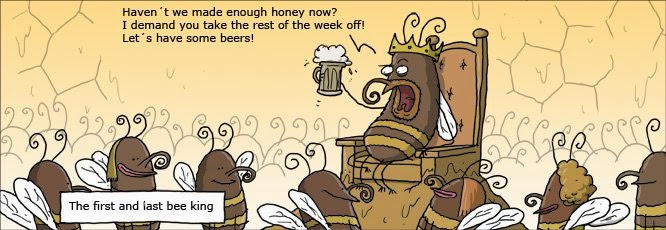An alternative look at some of the problems we beekeepers have. “The Practical Beekeeper, or Beekeeping Naturally has some observations that all should read.
My issue is the continued use of Oxalic acid as a ‘safe’ way to treat Varroa mites. There always is as much controversy on this as there are beekeepers. Same for the Formic acid.
| Most use a dribble method or paper soaked towels with glycerin. And the killing or control occurs as the acid penetrates the mite through the feet. Dribble or vaporize it, no matter, the oxalic acid builds up on the feet where it forms a crystal. A few hours later the mite is dead. Consider it GOUT on steroids. | 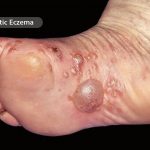 |
Now I always wondered why not the feet of the bees? It seems that the mites have adhesive lobes on their feet that help them stick to the surface of their target. The bee! Bees are not harmed through vaporization because they have a different mechanism, but dribbling can be harmful to the bees as they eat the sugary solution and the acid does harm the walls of their guts.
Glycerine and Oxalic acid paper towel treatments usually involve : 25 ml of glycerin, 25 grams of oxalic acid, and one shop towel for every hive. What I noticed however was that the bees generally do not consume these shop towels especially when draped in half sheets. Somehow they seemed reluctant to partner up and drag these things out.
Now as a plantsman I see that they are always quick to drag the unexpected debris out, things such as absorbent materials you slopped over while putting on an insulating quilt frame. The moss would quickly be dragged down and thrown out. So think I, why not use rhubarb leaves??? Cut them up in narrow strips and drape crosswise over the brood frames.
Rhubarb leaves contain 0.5-1.0% oxalic acid, leaf 0.59 – 0.72 grams. When it comes down to it, Oxalic acid is a nephrotoxin that affects the kidneys and is a corrosive acid that carries tons of warnings about getting into ones eyes and or inhaling the vapors. So WHY is it safe on bees who have many more breathing orifices than we humans. Worse yet studies show that when applied to rats a fatal does of oxalic acid is about 22 grams. (Some suggest even less.) So, feed that paper towel treatment to a rat and it would be a dead rat.
For humans the lethal dose is higher but I would not go about suggesting eating the 25 grams of oxalic laden paper either. However, the scare about eating rhubarb leaves to make a lethal dose would mean that you might need a very large salad of leaves. At about .5g/100g fresh weight, some five kg. of leaves would need to be ingested. More so for the stalks of the plant which we so love. The fact that there are some oxalic reduced Rhubarb cultivars may be that over-ingesting rhubarb in any form can lead to kidney problems.
| SO, why not use rhubarb leaves on your hives? Lets try to get some organic juices flowing. For one, I have always found rhubarb applications to bee stings to be super helpful. It also helps reduce further stinging by masking the attack pheromones. Native Americans and heck even my grandmother used to teach that the antidote for a poisonous plant grew in close proximity to it. We simply needed to connect the two. I always plant rhubarb near my hives!!! | 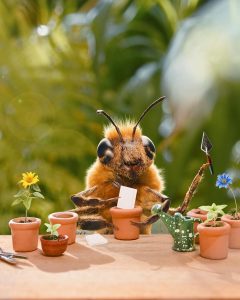 |
We however live in an industrial world and oxalic acid is easier to be found at Home Depot than out by the compost heap. Too many of us have forgotten that a lot of those old “wives tales/remedies” actually worked and were, in fact, the seed for the ever profitable pharma business of today.
So why not extract the juice from the rhubarb leaves and place in a shallow container and treat via vapor such as one would with Menthol for trachea mites? Menthol is a natural occurring medication. I have attempted to dry, then freeze and pulverize into sugar the stalks of my rhubarb and then added the powder to my confection’s sugar and sugar dusted the bees. This may have been a gastrointestinal mistake, if they ingested any, aside from simply grooming it off. The thyme and mint oils are totally safe to use in such applications.
Applying cut leaves that would be dismembered and carried out would be less of an issue. Housecleaning vs. body-grooming. Neither come naturally to me.
Or. maybe the leaves could be dried and used as smoker fuel
Putting narrow strips of rhubarb leaves on top of the brood chambers might work as the Oxalic acid would get spread around as they chew up the leaf and remove it. The experiment would be to monitor bee mortality as well as doing mite count drops after such leafy applications.
There’s probably not enough oxalic acid in the leaves to do the job, and if there was, you’d have to do something like put a bunch of leaves in juicer and then spray the resulting stuff all over the bees and the inside of the hive.
Juicing and then adding to sugar and pulverizing it in a blender to add to confectioners sugar did seem to work but again, what were the long term consequences to the health of the bee?
| More to the point, the bee itself needs to learn hygienic behavior and learn to deal with this parasite. I doubt anything we do will provide the answer to controlling an insect that feeds on fish, plants and anything that flies or crawls. The mite is one of the original insects and is not going to go away meekly. |
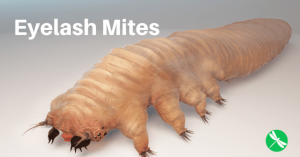 Your pretty eyelash mites. |
The fundamental question it seems is can we even keep bees without treatments? Are some succeeding? Are swarm behaviors one answer to this mite problem?
Varroa mites are a bitch, but after this dreadful winter and spring I see that others are having the same problem – getting their hives much less their nucs through a winter.
Michael Bush has the same concerns I have had. (check it out) http://bushfarms.com/bees.htm
His basic tenants are these!
1. ‘Unsustainable beekeeping system’
| “Beekeeping now has the dubious honor of becoming the first part of our system of industrial agriculture to actually fall apart. … we move them around more often, expose them to still more toxic substances, or fill the equipment up again with more untested and poorly adapted stock.’ | 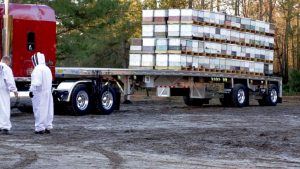 |
2. Shallow Gene Pool
We have a narrow gene pool to start … many of the pockets of feral bees have been depleted leaving only the queens that people buy. When you consider that there are only a handful of queen breeders providing 99% of the queens, that’s a pretty small gene pool.’ Worse yet, how they are banging them out is another topic. Buy LOCALLY!
3.Contamination
‘The other side of the pest issue is that the standard answer offered by the experts has been to use pesticides in the hives by beekeepers to kill the mites and other pests. But these build up in the wax and cause sterile drones which in turn causes failing queens. One estimate I heard puts the average supersedure rate at three times a year. That means the queens are failing and being replaced three times a year. This is stunning to me since most of my queens are three years old.’
4. Wrong Gene Pool
The other side of helping bees with treatments of pesticides and antibiotics is that you keep propagating the bees that can’t survive. This is the opposite of what we need. We beekeepers need to be propagating the ones that can survive. (In doing so we also keep propagating the pests that are strong enough to survive our treatments.) So we keep breeding wimpy bees and super pests. Even worse, we have bred bees not to rear drones, be larger, and use less propolis. Some of these make them re-productively challenged (less drones and larger bees hence larger slower drones) and some make them less able to handle viruses (less propolis).’ (Worse yet we bring in hundreds of packages of Italian bees here in the Northwest where they struggle to make it. And the yearly plaintiff wail, “My packaged died. What can I do???”)
5. Upset ecology of the bee colony
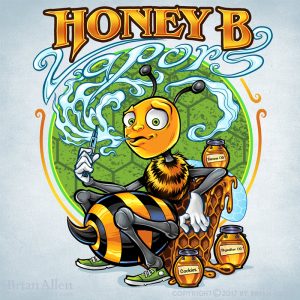 |
A bee colony is a whole system in itself of beneficial and benign fungi, bacteria, yeasts, mites, insects and other flora and fauna that depend on the bees for their lively hood. Pest controls tend to kill the mites and insects. All of the antibiotics used by beekeepers tend to kill either the bacteria (Terramycin, Tylosin, essential oils, organic acids and thymol do this) or the fungi and yeasts (Fumidil, essential oils, organic acids and thymol do this). The whole balance of this precarious system has been upset by all the treatments in the hive. And recently beekeepers switched to a new antibiotic, Tylosin, which the beneficial bacteria has not had a chance to build up resistance to and they have switched to formic acid as a treatment which shifts the pH radically to the acidic and kills many of the microorganisms of the hive.’ |
Will biopesticide’s be an alternative? Perhaps, a new heat-resistant fungus might help fight varroa mites. More expensive?, yes, but locally derived soil fungi may well prove a safe new tool. It does not take much to miscalculate oxalic acid concentrations or apply them inaccurately and all too many other chemical miticides can cause reproductive problems. We are not going to Neem oil our way to an answer with pollinators. Mycorrhiza may be one answer.
6. Natural Cell Size
‘Next we beekeepers need to control the pests in a natural way. We will elaborate more on this as we go, but Dee and Ed Lusby arrived at the conclusion that the solution to this was to get back to natural cell size. Foundation (the source of contamination in the hive from pesticide buildup in the world beeswax supply) is designed to guide the bees to build the size cells we want. Since workers are from one size and drones from another and since beekeepers for more than a century have viewed drones as the enemy of production, beekeepers use foundation to control the size cells the bees make. ….’
Natural Cell Size And it’s implications to beekeeping and Varroa mites
| (I would add that bringing in starter foundation from contaminated Chinese sources as the primary source of new hive foundations is a huge mistake. Here is a picture of them having to use humans as pollinators as all their own have died from the pesticides.) |  |
(Natural cell size is produced when bees draw their own foundation and with natural cell size we get one control of the Varroa population and we can keep bees alive without all the treatments. Sadly, there are few bee suppliers who can process out your own saved wax and mail back new foundation. Back in the 80’s my supplier Diamond International was always happy to do this.) What one can do to get back to SMALLER and Natural Cell Sizes. Remember regression to smaller cells is difficult. Large bees from our normal foundation cannot build natural sized cells. They build something in between. 5.1 mm worker brood cells. The NEXT cycle will and can build cells in the 4.9 mm range. A few bee companies like Dadant do offer such foundation. SUPPORT them but read their cautions!
What one can do to get natural sized comb.
- Top Bar Hives
- Foundationless Frames
- Blank Starter Strips
- Free Form Comb
- Empty Frame Between Drawn Combs
- Caucasian bees seem to make smaller frames naturally.
- Honey and real pollen are the proper food of bees. Sugar syrup has a much higher pH (6.0) than Honey (3.2 to 4.5) (Sugar is more alkali). Stating the same thing conversely, honey has a much lower pH than sugar syrup (Honey is more acidic). This affects the reproductive capability of virtually every brood disease in bees plus Nosema. The brood diseases all reproduce more at the pH of sugar (6.0) than at the pH of honey (~4.5). And this is not to mention that honey and real pollen are more nutritious than pollen substitute and sugar syrup. Artificial pollen substitute makes for short lived, unhealthy bees. (So if you HAVE to feed that damn sugar, be sure to add some organic apple cider vinegar to it.) I also add a dash of salt.
